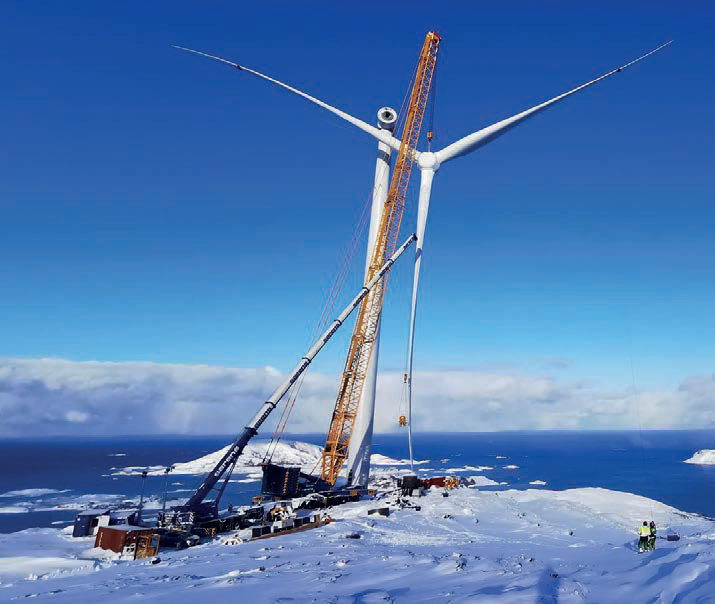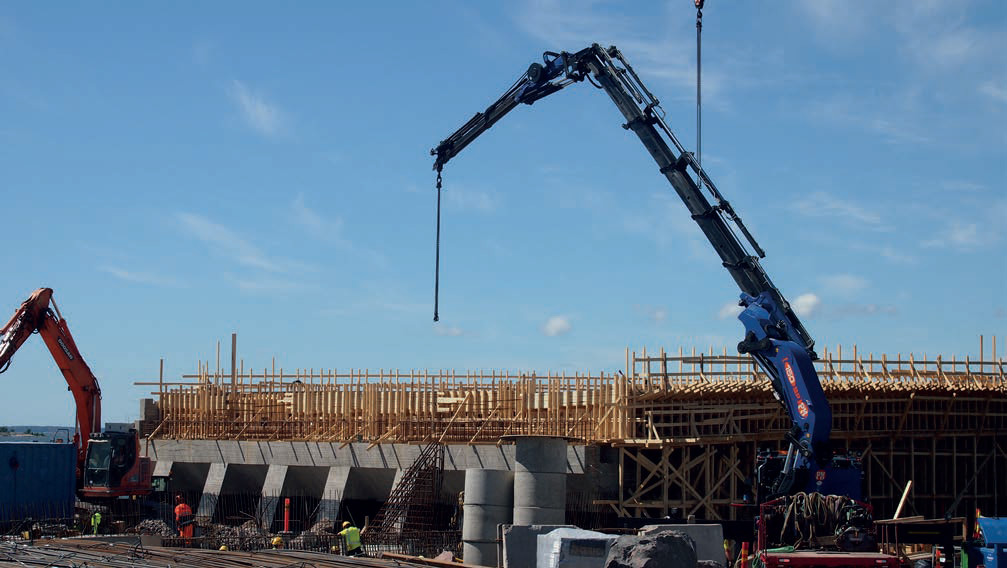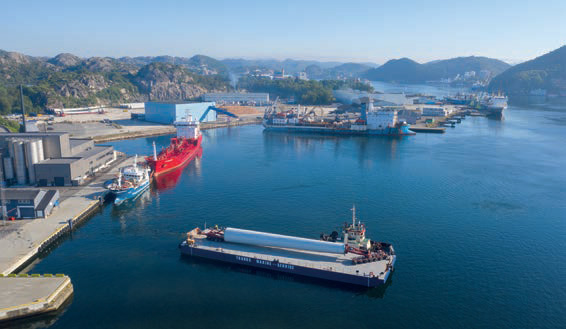Northern Lifts
14 August 2020From lifting trees to installing wind turbines, from city centres to mountain tops, crane companies in Scandinavia have been busy in recent months. Sotiris Kanaris reports.
The Scandinavian crane market is an important one for crane manufacturers, as many local companies have been investing heavily in new and high-end machines. This should come as no surprise, as they often have to perform lifts in adverse weather conditions—heavy snowfall and strong winds—as well as on challenging terrain.
An example of such a job was Sarens’ installation of 67 wind turbines at a wind farm in Kvitfjell Raudfjell, Norway. From November through April, the worksite was covered in snow as deep as seven metres in some areas. Meanwhile, wind speeds sometimes reached almost 40m per second.
Sarens carried out the erection of the turbines on behalf of FairWind and Siemens Gamesa, using high capacity lattice boom mobile cranes and all terrain cranes. When the project started in August 2019, there was only one main crane, the 750t Liebherr LG 1750 lattice boom mobile crane.
It was used in SL22 configuration with 105m boom and 250t counterweight. A Demag AC 220- 5 auxiliary crane was deployed for tailing the wind turbine components, and a Terex Explorer 5500 as a second auxiliary crane for relocating the main crane.
“After three months, the client decided to order one more main crane team, and from November 2019 onwards we also had the LG 1550 and AC 200 as a second main team,” said project manager Adam Kopaczewski. The 550 LG 1550 was used in SL configuration with 98m boom and 200t counterweight.
Sarens said: “An advantage of using the LG 1750 and LG 1550 cranes was that they did not need an SL for assembling this particular type of wind turbine at a worksite difficult for crawler cranes to manoeuvre.
"The wind farm is located on a mountaintop, and when relocating crawler cranes from one pad to another, the crew would have had to completely disassemble them. This is why Sarens opted for mobile lattice boom cranes, saving considerable time when moving cranes.”
A third preassembly team joined later, which used a Demag AC 500-2 in HASSL configuration to assemble the first two tower sections and a Terex Explorer 5500 auxiliary crane for tailing and relocating the 500t crane.
All cranes arrived via special vessel and were unloaded 40km away from the project site, at Tromso harbour. Then, Sarens transported the crane components to the site via truck.
Assembling the cranes proved challenging; Sarens had to use a special container to support the main boom because the level difference between the main crane’s hardstand and the boom assembly area was sometimes as great as 10m.
The Sarens crew lifted all wind turbine components, including three tower sections, the nacelle, the generator, and full rotor. The largest load was the nacelle and generator, which weighed 103.5t.
Over time, wind turbines have become bigger and their components heavier, sometimes requiring alternative methods of transportation. For example, Mammoet had to use a barge for a recent job.
Mammoet was tasked to deliver 29 Siemens Gamesa wind turbines to two project sites, Stigafjellet (seven turbines) and Maakaknuten Windpark (22 turbines), located close to Egersund in Norway.
Mammoet’s scope of work consisted of port handling, barging, transport and offloading components; or, in other words, 312 single and heavy transports.
To transport the main components of the wind turbines, Mammoet used a number of different semi-trailers and low beds. For the transportation of blades Nooteboom’s Super Wing Carrier was used.
Transport over the Eigerøy bridge is restricted to maximum weight of 100t, so the towers and generators travelled part of the journey on a barge. Blades, hubs and nacelle back-ends were transported by use of the bridge. For offloading, Mammoet used one 250t and two 100t mobile cranes from its German branch.
Furthermore, a 130tm knuckle boom crane fitted on an 8x8 chassis was used for unloading smaller components and providing pulling assistance up steep gradients.
Building Facilities
Another recent job from Norway, involved the construction of logistics and distribution centre on the outskirts of Oslo, the country’s capital. Nordic Crane used its new Kobelco CKE1350G-2 crawler crane with a luffing jib for this project.
The 150t CKE1350G-2, the first Kobelco crawler crane in Nordic Crane’s rental fleet, was working for pre-cast concrete producer Contiga Heidelberg Cement at the site.
The crawler was moved to the site last October, using a step deck/drop trailer and six “standard” flatbed trailers from Nordic Crane’s own fleet, where it remained until the end of February.
The CKE1350G-2’s duties at the site included lifting pre-cast concrete and steel elements of up to 15t to a maximum distance of 26m and a height of 8m for the construction of the logistics and transport hub’s storage facilities.
To complete the lifts the CKE1350G-2 has been fitted with a 32m-long main boom and 32m-long luffing jib, which thanks to the cable guy support at the top of the boom allows for easy erection of the rear strut without the need of an additional crane during assembly. “Thanks to the extended boom configuration and the CKE1350’s excellent manoeuvrability, once assembled there is no need to extend or retract the outriggers every time it needs to move around the site,” Kobelco said.
Another plus when using the luffing jib is that the CKE1350G-2 can work closer to the structure under construction thanks to the ability to raise and lower the jib between 68° and 88°.
In neighbouring Sweden, Havator has recently supplied a Liebherr all terrain crane for the construction of an industrial building in Obbola.
SCA needs to increase its production significantly to meet a growing demand for paper packaging. Demand is driven by population growth, e-commerce and not least the ambition to reduce plastic use.
Currently, the company’s paper mill in Obbola annually produces 450,000t of kraftliner, a paper product used for the outer layer in corrugated cardboard boxes. The plan is to increase production to 725,000t per year. To cope with this, a new paper machine and a new industrial building is required.
The construction project is called Expansion Obbola PM2. The main building will be 292m long, 54m wide and about 30m high.
The assembly of the concrete walls is done by Havator and will begin in August this year and will be completed in June next year. The project should be completely ready by the beginning of 2023.
Liebherr’s rental department has supplied two large ECH-1000 hammerheads for the construction of a new BASF battery factory in Pyhäjoki, Finland. One crane has a maximum capacity of 40t, 50m jib length and 38m hook-height.
The other unit has 50t maximum capacity, 70m jib length and 55m hook-height. Both are mounted on foundation anchors. The duration of the rental contract is one year.
City Jobs
In the capital of Finland, Helsinki, there is a construction project at the West Harbour, the country’s busiest passenger harbour.
There is heavy vehicle traffic going through this harbour to St. Petersburg, Russia and Tallinn, Estonia. The City of Helsinki has started few projects to improve both, passenger and vehicle traffic.
A PM150028SP+J2416.25 loader crane from Nosto ja Kuljetus Karttunen’s fleet has been put to work there. It has recently performed lifts to help with the construction of a bridge.
A big urban project is also underway in Sweden’s capital Stockholm. The New Slussen project will transform the lock, built in 1642, that separates the sea from the fresh water of Lake Mälaren.
Under the new plan, there will be a large pedestrianised public space, mixed use buildings and bridges. The project’s centrepiece is a 3,400t steel bridge that is 140m long, 45m wide, with a varying height of one to seven metres. There are eight Liebherr tower cranes working on this project. The biggest ones are two 40t capacity hammerheads with 80m jibs: a 1000 EC-H with 52m hook-height and a 630 EC-H with 58m hook-height.
Another major project in Sweden where Liebherr tower cranes have been supplied is the Västlänken (West Link) railway project. A double track railway tunnel will provide commuter and regional trains with their own tracks in a tunnel beneath central Gothenburg.
On behalf of the Swedish Transport Administration, NCC is building a substantial section of the Västlänken. NCC’s contract covers a new bridge over the E6 motorway in the east, a sunken rail line, a rock tunnel through Gullberget, a concrete tunnel in clay and the underground commuter train station Centralen just north of Gothenburg Central Station, plus a continuation of the concrete tunnel west to GöteborgsOperan. Among the equipment used for this project are seven Liebherr tower cranes.
Inevitably a new railroad being built in a city centre affects the urban landscape. Gothenburg’s local authority wanted to save the 300 trees situated on the jobsite, so for several years it planned their move in order to ensure their survival.
For the biggest tree moves Kynningsrud Nordic Crane was appointed. The biggest tree of all was an 186t beech. For its move, Kynningsrud Nordic Crane deployed its 600t Demag CC 2800-1 crawler crane.
“This is the biggest tree move in northern Europe. We had to lift the tree, turn the crane 180° and then crawl 75m and replant the tree,” said Morten Heli-Hansen, CEO at Kynningsrud Nordic Crane. Some of the challenges of this job cited by the company were the difficulty to know the exact weight and balance point of the tree, as well as the city’s traffic.
In Gothenburg there are also a lot of residential and office buildings under construction.
One of the biggest projects is the Karlastaden mixed city development by Serneke Group, which will cover 32,000sqm and ten city blocks. It will feature apartments, offices, shops, restaurants, a medical centre and school. In the centre of the development will stand the 245m, 73-storey Karlatornet skyscraper; once finished, this will be the tallest building in Scandinavia. Flens Byggmaskiner has supplied two Terex CTL 430-24 and one Terex CTL 272-18 luffing jib tower cranes for the high-rise project. Terex tower cranes are also being used for other projects in Gothenburg.
Cranbalt, Terex’s newly appointed tower crane dealer for Sweden, has supplied two CTT 332-16 and one CTT 721-40 flat tops for the construction of the Citygate office building in the city’s Gårda district.
The building will have 36 floors and will reach a height of 144m. Cranbalt has also put to work its Terex CTT202-10 and CTT332-16 flat tops on the construction site of the Mölnlycke Fabrikk residential development.
Kran Elektro has more than 50 years of experience in rental, sale and service of ower cranes, hoists and lifts in Denmark. It is a dealer of a number of brands including in Comansa.
Kran Elektro is currently using ten Comansa cranes for the construction of a new university hospital in Odense, Denmark.
The units used belong to the following flat top models: 16LC260, 21LC290, 21LC335, 21LC400, 21LC450. They were erected in 2017 and will remain at the jobsite for up to four years.
Over the last three months, Kran Elektro has also erected two 21LC550 20T, a 21LC660 25T and a 21LC450 20T, for the construction of the Nicolinehus development in Aarhus, Denmark.
Nicolinehus will be a 45,000sqm residential and commercial complex. The cranes are expected to be at the site for 1.5–2 years.
On these sites, the cranes are used for many different tasks, including lifting concrete buckets and building elements.
Despite the negative economic effect of the pandemic, local crane companies and manufacturers are optimistic that the activity will not drop substantially. Cranes Today was told about many upcoming projects including: hospitals, bridges, highways and residential developments.
Sliding under bridge
A 310t capacity Hydra-Slide low profile skidding system was the centrepiece of a multifaceted transformer delivery and installation in Sweden recently.
The LP350 skidded the 240t transformer under an overpass—a planned manoeuvre on the 40km route from Sundsvall to Nysäter— and then into its final position. The 11m long, 3.8m wide, 4.7m high transformer was delivered by Jinert, a Swedish lifting and material handling company, for its customer, transport and logistics firm DSV.
Including the truck, the entire transportation weighed in at 327t. Jinert purchased the LP350 after having attended Rapid Response Solutions’ open house event at its Portsmouth, UK facility last September.
Joakim Andersson, heavy project division at Jinert, said: “We already had an extensive fleet of equipment, but we were challenged with the sliding, lifting and transportation of a transformer from a vessel to its foundation; it was a big project. The planning survey meant that en route we had to unload and slide the transformer under a bridge, reload it and continue the journey, which was the most efficient method of getting it to the site. A requirement was to stay as low as possible, which is why our research led us to the Hydra-Slide product. We worked with a 10cm margin between the transformer and the overpass, sliding approximately 35m.”
An overnight road closure was implemented to facilitate the underpass slide. Cold weather and snow presented further challenges.
There was an added complication beneath the bridge because of a gradient. By contrast, the 12m slide onto the foundation was easier as the ground was flat. A track length of 18m was used throughout with steel plates to distribute ground bearing pressure. The skidding system was powered with a split flow pump and a hydraulic gantry was used to lower the transformer onto the skidding equipment.
In addition to the skidding equipment and gantry, Jinert also used jacks and a heavy trailer.
Grove ATs head to Norway
Crane Norway Group recently purchased nine new Grove all terrain cranes to meet increased demand from customers for heavy lifting capacity cranes.
Along with five new units of the 250t Grove GMK5250XL-1, Crane Norway Group has also taken delivery of two 300t GMK6300L-1, one 150t GMK5150L and one 60t GMK3060L.
UN Mobilkraner, Manitowoc’s dealer in Norway, finalised the sale in October 2019. The nine Grove cranes have been shipped from Manitowoc’s plant in Wilhelmshaven, Germany, to Norway.
The GMKs will be used for a variety of jobs—from small construction sites to the installation of wind farms and major oil and gas construction projects. The cranes will also be working offshore on oil platforms in the North Sea where they will help carry out maintenance and construction jobs.
“We already own 15 Grove cranes and were looking for new models with outstanding lifting capacities to add to our fleet,” said Trond Helge Skretting, COO at Crane Norway Group. “We purchased our first Grove crane in 1986—a Grove TM760EN—and have added different GMK models to our fleet in recent years. We’ve always been extremely satisfied with the consistent performance and reliability of our Grove cranes, and so have our customers.
That’s why we selected the Grove all terrain cranes.”
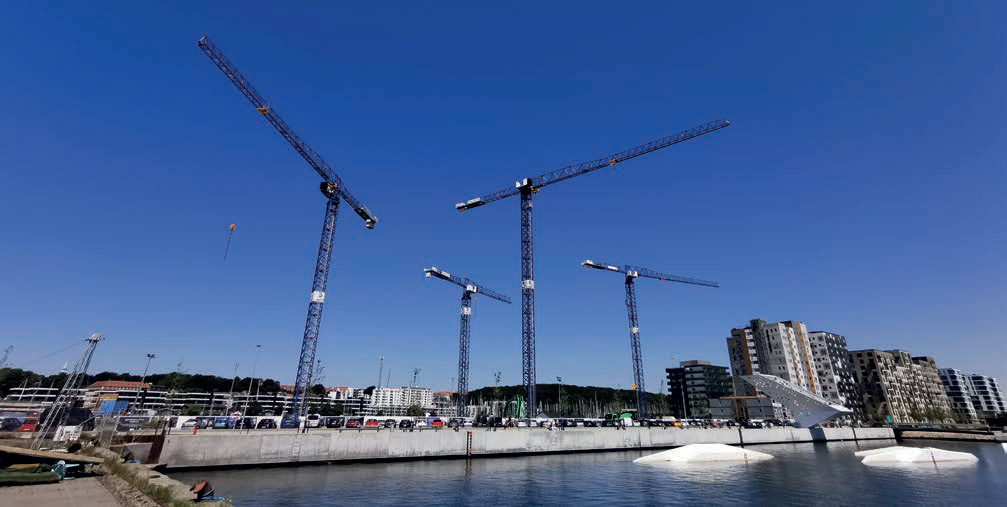 Kran Elektro is using Camansa flat tops (two 21LC550 20T, a 21LC660 25T and a 21LC450 20T) for the construction of the Nicolinehus development in Aarhus, Denmark.
Kran Elektro is using Camansa flat tops (two 21LC550 20T, a 21LC660 25T and a 21LC450 20T) for the construction of the Nicolinehus development in Aarhus, Denmark.
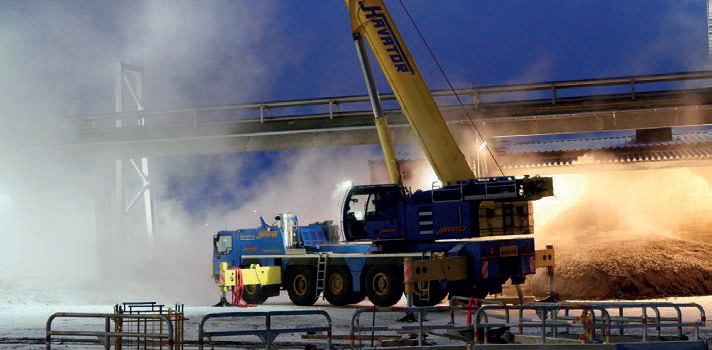 Havator has recently supplied a Liebherr all terrain crane for the construction of an industrial building in Obbola, Sweden.
Havator has recently supplied a Liebherr all terrain crane for the construction of an industrial building in Obbola, Sweden.
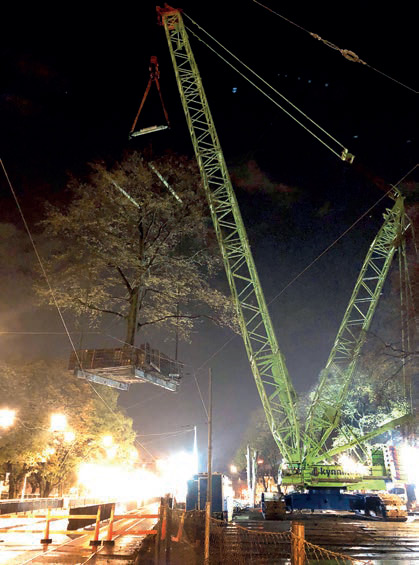 Kynningsrud Nordic Crane deployed its 600t Demag CC 2800-1 crawler crane for large tree moves in Gothenhurg, Sweden.
Kynningsrud Nordic Crane deployed its 600t Demag CC 2800-1 crawler crane for large tree moves in Gothenhurg, Sweden.
 A Terex CTT 721-40 supplied by Cranbalt for the construction of the Citygate office building in Gothenburg, Sweden.
A Terex CTT 721-40 supplied by Cranbalt for the construction of the Citygate office building in Gothenburg, Sweden.
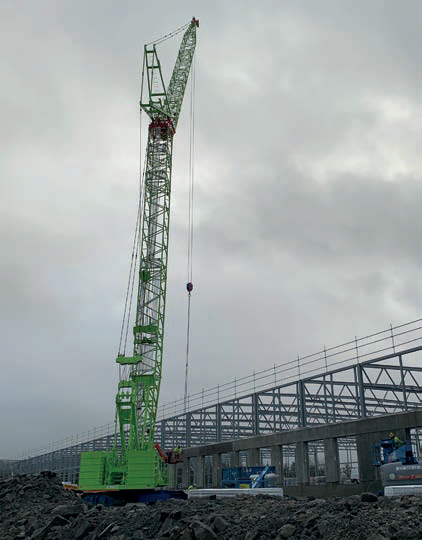 Nordic Crane used its new Kobelco CKE1350G-2 crawler crane with a luffing jib for the construction of a logistics and distribution centre on the outskirts of Oslo, Norway.
Nordic Crane used its new Kobelco CKE1350G-2 crawler crane with a luffing jib for the construction of a logistics and distribution centre on the outskirts of Oslo, Norway.
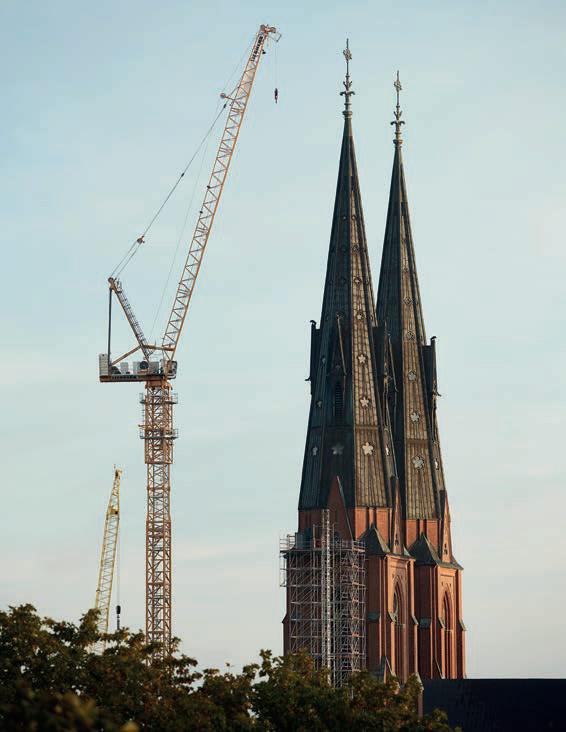 A Liebherr 190 HC-L luffer is being used for the renovation of a church in Uppsala, Sweden. The crane has a freestanding height of 100m and has been erected on a 3m-high 10m x 10m concrete foundation.
A Liebherr 190 HC-L luffer is being used for the renovation of a church in Uppsala, Sweden. The crane has a freestanding height of 100m and has been erected on a 3m-high 10m x 10m concrete foundation.
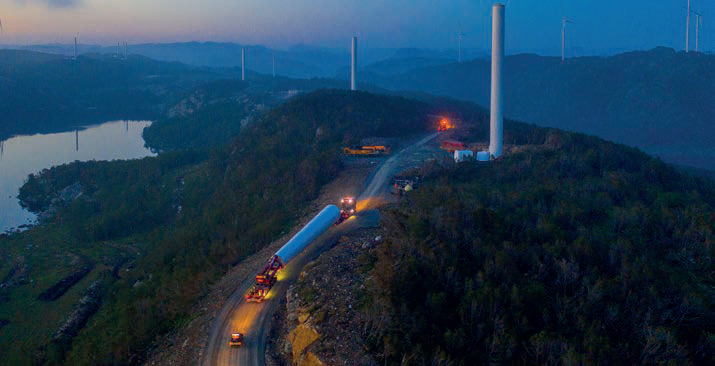 Mammoet was tasked to deliver 29 Siemens Gamesa wind turbines to two project sites close to Egersund in Norway.
Mammoet was tasked to deliver 29 Siemens Gamesa wind turbines to two project sites close to Egersund in Norway.
